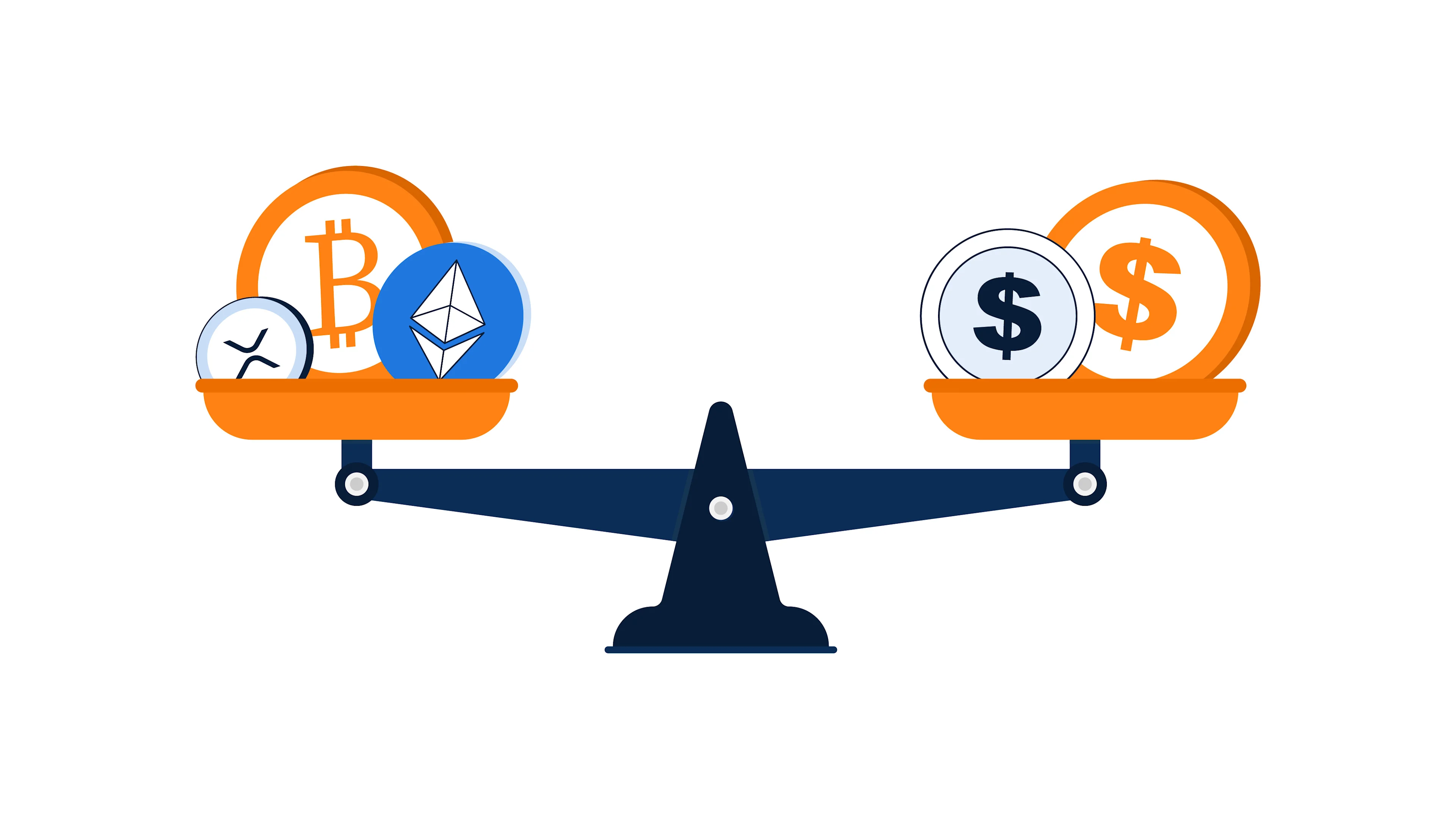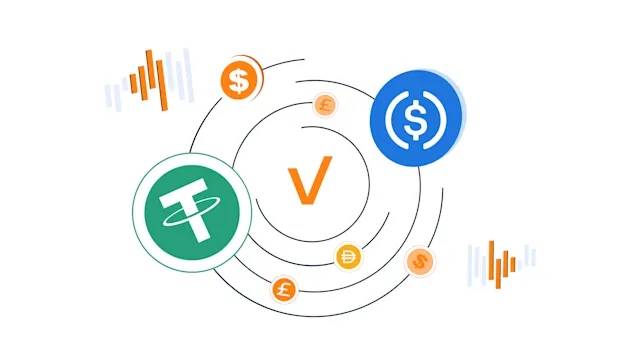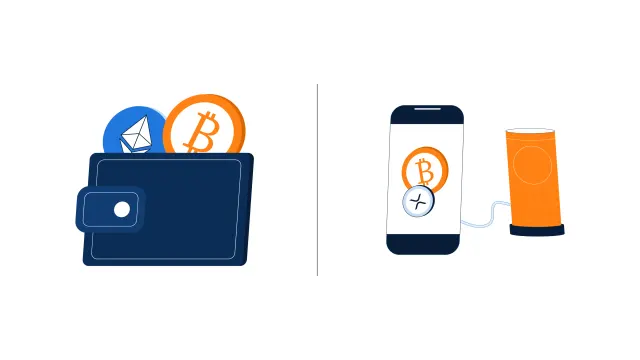
Stablecoins vs Algo Stablecoins
Stablecoins are digital assets designed to maintain a fixed value of a fiat currency or asset over time.
What is a stablecoin
Stablecoins are digital assets designed to maintain a fixed value of a fiat currency or asset over time. For example, it can be pegged to the Dollar, Euro, Dirham, Dinar, Gold, or Oil. Stablecoins enable traders and investors to manage the high volatility of cryptocurrencies by allowing users to lock in profits or cut losses by transferring value to a stable price while remaining on the blockchain. Before stablecoins, traders had to convert their cryptocurrencies to fiat, which was lengthy and costly, but now they can rely on stablecoins such as USDT, USDC, BUSD, UST, PAXG, and more.
Types of stablecoins
Stablecoins are minted on the blockchain like any other cryptocurrency but with the mechanism to stay pegged to its underlying asset. Stablecoins vary in the underlying collateral backing them, including four main methods; Fiat backed, crypto-backed, commodity-backed, and algorithmic. Even though stablecoins can be formed through different structures, the underlying objective remains the same; price stability. While some methods have been more successful than others, stablecoins are never a guaranteed peg as they may have small fluctuate or completely fail to uphold their peg due to an increase or decrease in demand.
Fiat Backed
A fiat-backed stablecoin keeps the underlying fiat currency in its reserves, for example, USD or Euro. Fiat collateralized stablecoins have a 1:1 ratio (backing); the reserves equal the number of coins (tokens) minted through cash or cash equivalents. This enables users to convert their cryptocurrencies at the pegged rate of the underlying currency. The stability of a country's economy (currency) reduces the fluctuation of a stablecoin; that is why most stablecoins are pegged to stronger and more stable currencies such as the USD or Euro. Naturally, an increase or decrease in demand can shift the peg out of its position; thus, arbitragers are relied upon to bring the price back to a fixed rate. BUSD, USDT, and USDC are some of the more popular and largest fiat-backed stablecoins by market capitalization.
Commodity Backed
As the name suggests, a commodity-backed stablecoin is collateralized by different assets, mainly precious metals like gold or other commodities such as real estate and oil can be relied on. Commodities can appreciate in value over time, thus incentivizing users to hold commodity-backed stablecoins over fiat-backed ones. Commodities are more volatile than fiat currencies; thus, they can equally lose or gain value. Additionally, commodity-backed stablecoins enable users worldwide to invest in commodities otherwise not available locally. In some cases, users can redeem the underlying commodity in exchange for the coin or token they hold representing the asset. This is possible with Tether Gold (XAUT), Digix Gold (DGX), and Paxos Gold (PAXG), which are the most liquid and popular gold-backed stablecoins. Other commodity-backed stablecoins include Tiberius Coin (TCX), collateralized by seven different precious metals, and SwissRealCoin (SRC), backed by a Swiss real estate portfolio.
Crypto-backed
Even though it may seem like an oxymoron to have volatile cryptocurrencies backing a stablecoin, they are more reliable than fiat currencies when it comes to decentralization. Crypto-backed stablecoins are created and managed by smart contracts, while some are managed by Decentralized Autonomous Organizations (DAOs). Moreover, they rely on the least volatile currencies, such as ETH or BTC, and are overcollateralized to help absorb price fluctuations. Crypto-backed stable coins offer the power of decentralization, a trustless and transparent system. Additionally, some crypto-backed stablecoins are collateralized by different cryptocurrencies to distribute risk efficiently. Although, crypto-backed stablecoins are among the more complex types of stablecoins. The most famous example of crypto-backed stablecoins is Maker DAO’s DAI stablecoin.
Algorithmic
The final type of stablecoins is algorithmic stablecoins which are non-collateralized. They are built on an algorithm responsible for controlling the supply depending on the demand for the stablecoin. Essentially, the supply is increased when there is high demand and decreased by buying up tokens from the circulating supply when demand is low to maintain the peg. Algorithmic stablecoins are the most decentralized and independent stablecoins. Although they are not collateralized and depend on continuous growth; thus, there is a high risk for users to lose their money during market crashes, as seen recently with the Terra Luna UST stablecoin. Other examples of stables coins include Ampleforth (AMPL), Basis Cash (BAC), and Iron Finance (ICE), among others.
Pros and Cons of stables coins
Pros
Stability: stablecoins can be relied upon as cryptocurrencies for day-to-day transactions because they maintain a stable price. As a blockchain-based currency, it provides the added benefit of worldwide peer-to-peer transactions.
Investors and traders: Users can rely on stablecoins to lock in profits or cut losses upon trading cryptocurrencies without going off-chain. Moreover, some DeFi and CeFi platforms provide staking protocols that enable users to earn an RIO from the stablecoins instead of letting them sit idle, allowing investors to diversify their portfolios.
Regulation: despite the lack of regulation in the crypto markets, stablecoins, and especially fiat-backed and commodity-backed stablecoins, are subject to more scrutiny and regulation. This is because they are digital assets issued by centralized entities to hold their fiat and commodities reserve. They must pass through the existing regulatory processes.
Cons
Not guaranteed to maintain their peg: stablecoins are minted or burnt depending on the token's demand to maintain their peg. If the demand shifts dramatically (either up or down) or, more importantly, to the downside, investors will lose faith in it. This would result in a “bank run” or, in crypto terms, a death spiral. A death spiral is more likely to happen with algorithmic stablecoins because they are uncollateralized.
Lack of transparency: This is mainly an issue with non-decentralized stablecoins such as USDT and USDC. USDT has failed to produce public audits and only provided attestation from private accountants. Furthermore, stablecoins USDT has been at the forefront of accusations that suggest it is under-collateralized, and the Tether organization has remained unrevealing while making vague comments about its cash reserves.
Centralization of stablecoins: Fiat-backed stablecoins such as USDT are subject to regulation, which requires the developers to fully control the network. This goes against the basic premise of cryptocurrencies being decentralized.
Low RIO: stablecoins, as intended, remain at a fixed price; thus, investors cannot profit from price appreciation. Although investors can find protocols that enable them to invest their stablecoins to earn staking rewards, these returns are more likely to be less than what the volatile crypto market can offer.
Regulation: Most stablecoins rely on regulated assets (fiat-backed and commodity-backed stablecoins), which puts them within the regulatory sphere. Additionally, as more algorithmic stablecoins continue to crash, the demand for regulation, especially on stablecoins, continues to grow, and the introduction of government-issued stablecoins (Central Backed Digital Currency (CBDC)) becomes more of a reality. Given that the crypto markets remain widely unregulated, this creates a lot of regulatory uncertainty. Hence, unclear regulation makes it impossible to know which direction the authorities will take and could end up having a negative impact on certain stablecoins once implemented.
Analyzing Algorithmic stablecoins
With the recent unexpected crash of Terra Luna’s UST, it is important to understand the advantages and disadvantages of algorithmic stablecoins that may help understand the UST crash and the consistent failure of algorithmic stablecoins.
Advantages
Maintains a steady value which is needed for users to remain in the DeFi ecosystem without relying on traditional finance.
Some algorithmic stablecoins, such as the UST stablecoin, have utility within their ecosystem and the ability to earn high RIO (Terra offered a 20% interest on UST) simply through staking. These incentivize more users to join and participate in the ecosystem.
Completely decentralized, therefore censorship-resistant, and cannot be manipulated by any centralized entity.
Disadvantages
Uncollateralized, which allows users to create something out of nothing. This makes the system highly susceptible to a death spiral once the coin loses its peg.
Censorship resistant; thus, the system cannot be manually adjusted when crashing.
Historically doomed to fail; therefore, users and investors continue to lose faith in algorithmic stablecoins.



